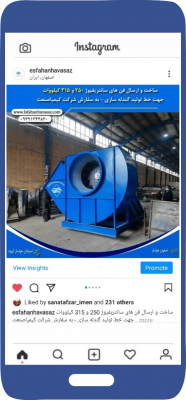WORKSHOP STATIC AND DYNAMIC BALANCE
Workshop Static and Dynamic Balance:
One of the essentials of working with fans or impellers is the knowledge of balance and handling vibrations. Vibrations is a rotary object leads to earlier bearing failure and making extra noise. Extra vibrations in a fan can have different reasons which one of most important is having imbalance.
Team balance Isfahan Air handling Co. , Steps of balancing a rotary part:
If rotor is considered fixed, the imbalance of rotor can be removed with 2 separated sheets. Different balance methods are Static balance (one sheet), Dynamic balance (two sheets) and Coupled balance (three sheets). For high speed rotor balance, fixed rotor method is assumed faulty, therefore, for balance of these rotors, Flexible Rotor method is used. There are two main types of balancing machines, hard-bearing and soft-bearing. The difference between them, however, is in the suspension and not the bearings.
In a hard-bearing machine, balancing is done at a frequency lower than the resonance frequency of the suspension. In a soft-bearing machine, balancing is done at a frequency higher than the resonance frequency of the suspension. Both types of machines have various advantages and disadvantages. A hard-bearing machine is generally more versatile and can handle pieces with greatly varying weights, because hard-bearing machines are measuring centrifugal effects and require only a one-time calibration. Only five geometric dimensions need to be fed into the measuring unit and the machine is ready for use. Therefore, it works very well for low- and middle-size volume production and in repair workshops.
A soft-bearing machine is not so versatile with respect to amount of rotor weight to be balanced. The preparation of a soft-bearing machine for individual rotor types is more time consuming, because it needs to be calibrated for different part types. It is very suitable for high-production volume and high-precision balancing tasks.
With the rotating part resting on the bearings, a vibration sensor is attached to the suspension. In most soft-bearing machines, a velocity sensor is used. This sensor works by moving a magnet in relation to a fixed coil that generates voltage proportional to the velocity of the vibration. Accelerometers, which measure acceleration of the vibration, can also be used.
A photocell (a sensor) is used to determine the rotational speed. with installation of a part or transparent ribbon on rotor, the time when the strip passes the photocell twice can be measured and rotor speed can be figured out, however, The length of ribbon should be long enough for photocell to detect.
Calibration is performed by adding a known weight at a known angle and measuring vibration vectors. In fact calibration is the vector caused by effect of the added weight and imbalance existing in rotor. With acquiring imbalance vectors (measuring vibrations), correction weights can be calculated without use of testing weight.
Imbalance Definition:
Imbalance is non-uniform distribution of mass around Symmetry axis of rotor. Imbalance is defined as following in ISO Standard: A situation in rotor, which effect of vibrations cause by Centrifugal force from center to bearings is created. Correction of this non-uniform mass distribution in rotor is called Balancing. In fact balancing covers faults in original defective product. Main reasons of imbalancing of rotor in production are these four:
* Materials do not have equal density. * Holes are not milled correctly in a line with center.
* Faults made in symmetrical or rotary milling * Assembly faults.
Imbalance can also be caused by these reasons even when machine is working properly
* Unexpected accumulation and sediment of materials in fan blade or pump
* Detachment or damage to Fan blades
* Thermal perturbation caused by temperature difference while working




